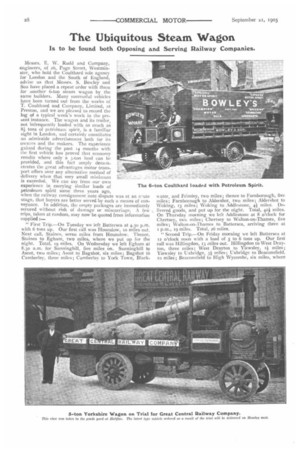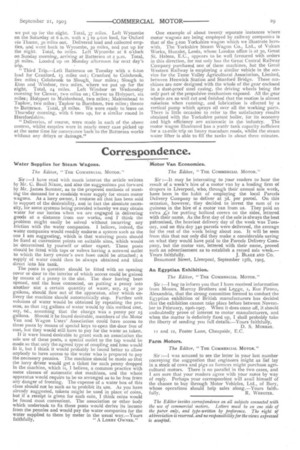The Ubiquitous Stearn Wagon
Page 12

Page 13

If you've noticed an error in this article please click here to report it so we can fix it.
Is to be round both Opposing and Serving Railway Companies.
Messrs. E. W. Rudd and Company, engineers, of 26, Page Street, Westmin ster, who hold the Coulthard sole agency for London and the South of England, advise us that Messrs. S. Bowley and Son have placed a repeat order with them for another 6-ton steam wagon by the
same builders. Many successful vehicles have been turned out from the works of T. Coulthard and Company, Limited, at Preston, and we are pleased to record the log of a typical week's work in the present instance. The wagon and its trailer, not infrequently loaded with as much as 81 tons of petroleum spirit, is a familiar sight in London, and certainly constitutes an admirable advertisement both for its owners and the makers. The experience gained during the past 14 months with the first vehicle has proved that economy results where only a 3-ton load can be provided, and this fact amply demonstrates the great advantages motor transport offers over any alternative method of delivery when that very small minimum is exceeded. We can say from our own experience in carrying similar loads of petroleum spirit some three years ago, when the railway consignment note dispute was at an a7ute stage, that buyers are better served by such a means of conveyance. In addition, the empty packages are immediately secured without risk of damage or miscarriage. A few trips, taken at random, may now be quoted from information supplied:—
" First Trip.—On Tuesday we left Battersea at 4.30 p.m. with 6 tons up. Our first call was Hounslow, to miles out. Next call, Staines, seven miles from Hounslow.. Thence, Staines to Egham, two miles, where we put up for the night. Total, 19 miles. On Wednesday we left Egham at 8.30 a.m. for Sunninghill, five miles on. Sunninghill to Ascot, two miles ; Ascot to Bagshot, six miles; Bagshot to Camberley, three miles; Camberley to York Town, Black
,ater, and Frimley, two miles ; thence to Farnborough, five miles; Farnborough to Aldershot, two miles ; Aldershot to Woking, 13 miles; Woking to Addlestone, 44 mileS. De
,. livered goods, and put up for the night. Total, 42i miles. On Thursday morning we left Addlestone at 8 o'clock for Chertsey, two miles; Chertsey to Walton-on-Thames, five miles; Walton-on-Thames to Battersea, arriving there at 1 p.m., 19 miles. Total, 26 miles. "Second Trip.—On Friday morning we left Battersea at ir2 o'clock noon with a load of 5 to 6 tons up. Our first call was Hillingdon, 13 miles out. Hillingdon to West Drayton, three miles; West Drayton to Yiewsley, Ti miles; Yiewsley to Uxbridge, miles; Uxbridge to Beaconsfield, to miles ; Beaconsfield to High Wycombe, six miles, where
we put up for the night. Total, 37 miles. Left Wycombe on the Saturday at 6 a.m. with a 3 to 4-ton load, for Oxford via Thome, 3o miles out. Delivered load and collected empties, and went back to Wycombe 30 miles, and put up for the night. Total, 6o miles. Left Wycombe at 8 o'clock on Sunday morning, arriving at Battersea at 2 p.m. Total, 36 miles. Loaded up on Monday afternoon for next day's trip.
"Third Trip.—Left Battersea on Tuesday with a 6-ton load for Cranford, 13 miles out; Cranford to Colnbrook, five miles; Colnbrook to Slough, four miles; Slough to Eton and Windsor, two miles, where we put up for the night. Total, 24 miles. Left Windsor on Wednesday morning for Clewer, two miles on ; Clewer to Holyport, six miles; Holyport to Maidenhead, two miles; Maidenhead to Taplow, two miles; Taplow to Burnham, two miles; thence to Battersea. Total, 38 miles. We were ready to leave on Thursday morning, with 6 tons up, for a similar round in Herefordshire.
"Deliveries, of course, were made in each of the above centres, whilst empties were in nearly every case picked up at the same time for conveynnce back to the Battersea works without any delays or damage." One example of about twenty separate instances where motor wagons are being employed by railway companies is that of the 5-ton Yorkshire wagon which we illustrate herewith. The Yorkshire Steam Wagon Co., Ltd., of Vulcan Works, Hunskt, Leeds, whose London office is at 30, Great St. Helens, E.G., appears to be well favoured with orders in this direction, for not only has the Great Central Railway Company purchased one of these machines, but the Great Western Railway is employing a similar vehicle in the service for the Teme Valley Agricultural Association, Limited, between Henwick Station and Stanford Bridge. These machines are now designed with the whole of the gear enclosed in a dust-proof steel casing, the driving wheels being the only part of the propulsive mechanism exposed. All the gear wheels are so well cut and finished that the motion is almost noiseless when running, and lubrication is effected by a vertical pump which sprays oil over all the working parts. There is little occasion to refer to the satisfactory results obtained with the Yorkshire patent boiler, for its economy and high efficiency are axiomatic in the industry. The motor wagon illustrated has a water tank capacity sufficient for a 12-mile trip on heavy macadam roads, whilst the steam water lifter is able to fill the tanks in about three minutes.
















